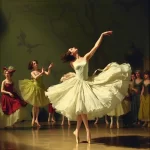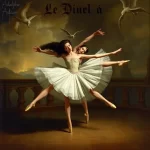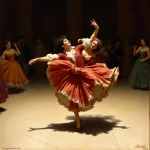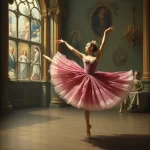Ballet: La Tragédie de Salomé (Florent Schmitt, 1907)

Introduction
La Tragédie de Salomé is a ballet composed by Florent Schmitt in 1907, with choreography by Loie Fuller. Premiering on November 9, 1907, at the Théâtre des Arts in Paris, this one-act ballet is a dramatic retelling of the biblical story of Salome, the stepdaughter of King Herod, who demands the head of John the Baptist as a reward for her dance. The ballet is known for its intense emotional depth, innovative choreography, and evocative musical score.
Historical Background
Creation and Development
The early 20th century was a period of significant artistic experimentation and innovation. The Symbolist movement, which emphasized the expression of emotions and ideas through symbolic imagery, heavily influenced the creation of La Tragédie de Salomé. The ballet was inspired by the biblical story of Salome, which had been popularized by Oscar Wilde’s play “Salome” and Richard Strauss’s opera of the same name.
Florent Schmitt, a prominent French composer, collaborated with Loie Fuller, an American dancer and choreographer known for her pioneering work in modern dance and stage lighting. Fuller’s innovative use of lighting and fabric to create ethereal, flowing movements complemented Schmitt’s lush, dramatic score, resulting in a groundbreaking ballet that pushed the boundaries of traditional dance and music.
Premiere and Reception
La Tragédie de Salomé premiered on November 9, 1907, at the Théâtre des Arts in Paris. The initial reception was mixed; while some critics praised the ballet’s innovative choreography and powerful music, others found it too avant-garde and emotionally intense. Despite the divided opinions, the ballet quickly gained a following and became a significant work in the early 20th-century ballet repertoire.
Notable early performances included revivals in Paris and other European cities, where the ballet continued to captivate audiences with its dramatic storytelling and innovative artistic elements.
Synopsis of the Ballet
La Tragédie de Salomé is a one-act ballet that unfolds in a series of dramatic scenes, each highlighting key moments in the story of Salome.
Detailed Summary
The ballet opens with a lavish banquet at King Herod’s palace. Salome, Herod’s stepdaughter, is introduced as a captivating and enigmatic figure. Herod, infatuated with Salome, promises to grant her any wish if she performs a dance for him.
Salome’s dance is a mesmerizing and seductive performance that captivates everyone present. As she dances, the music intensifies, reflecting the growing tension and anticipation. When the dance concludes, Salome demands the head of John the Baptist, who is imprisoned in the palace dungeon, as her reward.
Herod is horrified by Salome’s request but ultimately agrees to fulfill her wish. The executioner is summoned, and John the Baptist is beheaded. Salome receives the severed head on a silver platter and revels in her triumph. The ballet concludes with a powerful and haunting finale, as Salome’s actions lead to her own downfall and the collapse of Herod’s court.
Musical Composition
Composer’s Role
Florent Schmitt, a prominent French composer, played a crucial role in the creation of La Tragédie de Salomé. Known for his rich orchestration and innovative use of harmony, Schmitt’s score for the ballet is a masterful blend of dramatic intensity and lyrical beauty. The music enhances the emotional depth of the story, creating a powerful and immersive experience for the audience.
Musical Themes and Motifs
The score of La Tragédie de Salomé features several recurring musical themes and motifs that underscore the ballet’s dramatic narrative. One of the most notable motifs is the “Salome” theme, a haunting melody that represents the character’s seductive and enigmatic nature. The music also incorporates exotic scales and rhythms, reflecting the oriental setting of the story.
Schmitt’s use of orchestration is particularly effective in conveying the emotional intensity of the ballet. The lush strings, powerful brass, and intricate woodwind passages create a rich and dynamic soundscape that enhances the drama and tension of the story.
Famous Recordings and Performances
Several iconic recordings of La Tragédie de Salomé have been made over the years, showcasing the brilliance of Schmitt’s score. Notable recordings include those conducted by Jean Martinon with the Orchestre National de l’ORTF and by Leonard Slatkin with the Orchestre National de Lyon. These recordings capture the full range of emotions and musical intricacies of the ballet, making them essential listening for fans of classical music and ballet.
Choreography and Dance
Choreographer’s Vision
Loie Fuller’s choreography for La Tragédie de Salomé was groundbreaking in its use of innovative techniques and visual effects. Fuller, known for her pioneering work in modern dance, utilized flowing fabrics and dynamic lighting to create a sense of movement and emotion that was both ethereal and powerful. Her interpretation of the story emphasized the psychological and emotional complexities of the characters, particularly Salome.
Signature Dance Numbers
One of the most iconic dance numbers in La Tragédie de Salomé is Salome’s dance for Herod. This solo performance is a mesmerizing display of grace and seduction, with intricate choreography that highlights Salome’s allure and power. The dance is accompanied by Schmitt’s evocative music, which builds in intensity as the performance progresses.
Another key scene is the final tableau, where Salome receives the head of John the Baptist. The choreography in this scene is dramatic and emotionally charged, reflecting the culmination of Salome’s desires and the tragic consequences of her actions.
Notable Interpretations
Over the years, various productions of La Tragédie de Salomé have interpreted the choreography in different ways. Some productions have stayed true to Fuller’s original vision, while others have introduced new elements and styles to reflect contemporary trends in dance. Notable interpretations include those by choreographers such as Maurice Béjart and Serge Lifar, who brought their unique perspectives to the ballet.
Characters and Roles
Main Characters
- Salome: The central character of the ballet, Salome is a complex and enigmatic figure. She is both seductive and ruthless, driven by her desire for power and revenge.
- Herod: The king and stepfather of Salome, Herod is infatuated with her and ultimately grants her wish for John the Baptist’s head.
- John the Baptist: A prophet imprisoned in Herod’s palace, John the Baptist becomes the tragic victim of Salome’s desires.
Supporting Characters
- Herodias: Salome’s mother and Herod’s wife, Herodias plays a secondary role in the story but is an important figure in the background.
- The Executioner: The character responsible for carrying out Salome’s request to behead John the Baptist.
Famous Dancers
Several notable dancers have portrayed the roles in La Tragédie de Salomé over the years. Loie Fuller herself performed the role of Salome in the original production, bringing her unique style and vision to the character. Other famous dancers who have taken on the role include Isadora Duncan, who brought her own interpretation to the character, and more recently, modern dancers who have reimagined the role for contemporary audiences.
Cultural and Artistic Impact
Influence on Ballet and Dance
La Tragédie de Salomé has had a significant influence on the world of ballet and dance. Its innovative choreography and dramatic storytelling have inspired other choreographers and composers to explore new artistic possibilities. The ballet’s emphasis on emotional depth and psychological complexity has also contributed to the development of modern dance as an expressive art form.
Cultural Significance
The ballet’s story and themes have resonated with audiences and artists across different media. The character of Salome has appeared in various adaptations in literature, theater, and film, reflecting the enduring fascination with her story. The ballet’s exploration of themes such as desire, power, and revenge continues to captivate audiences and inspire new interpretations.
Legacy and Revivals
La Tragédie de Salomé has been revived and reinterpreted numerous times since its premiere. Major revivals have taken place in Paris, New York, and other cultural centers, each bringing new perspectives to the ballet. Contemporary choreographers and directors have also adapted the ballet for modern audiences, ensuring its continued relevance and popularity.
Iconic Productions
Historic Productions
One of the most famous historical productions of La Tragédie de Salomé was the original 1907 premiere at the Théâtre des Arts in Paris. This production featured Loie Fuller as Salome and showcased her innovative choreography and stagecraft. Other notable historical productions include revivals in the 1920s and 1930s, which introduced new interpretations and styles to the ballet.
Contemporary Productions
Recent productions of La Tragédie de Salomé have continued to explore new artistic possibilities. Contemporary choreographers have incorporated modern dance techniques and multimedia elements to create fresh interpretations of the ballet. These productions often emphasize the psychological and emotional aspects of the story, making it relevant to today’s audiences.
Production Design
The production design of La Tragédie de Salomé has evolved over the years, with each production bringing its own unique visual elements. The original production by Loie Fuller featured innovative use of lighting and fabric to create a sense of movement and emotion. Modern productions have incorporated advanced stage technology, elaborate sets, and costumes to enhance the visual impact of the ballet.
Critical Reception and Reviews
Initial Critical Response
The initial critical response to La Tragédie de Salomé was mixed. While some critics praised the ballet’s innovative choreography and powerful music, others found it too avant-garde and emotionally intense. Despite the divided opinions, the ballet quickly gained a following and became a significant work in the early 20th-century ballet repertoire.
Modern Reviews
Contemporary critics and audiences continue to appreciate La Tragédie de Salomé for its artistic innovation and emotional depth. Modern reviews often highlight the ballet’s powerful storytelling, evocative music, and groundbreaking choreography. The ballet’s exploration of timeless themes such as desire, power, and revenge ensures its continued relevance and popularity.
Fun Facts and Trivia
Behind-the-Scenes Stories
One interesting behind-the-scenes story involves Loie Fuller’s innovative use of stage lighting. Fuller experimented with colored gels and electric lights to create dramatic visual effects, which were groundbreaking at the time. Her techniques influenced future generations of choreographers and stage designers.
Notable Performers
Several famous dancers have been associated with La Tragédie de Salomé over the years. In addition to Loie Fuller and Isadora Duncan, other notable performers include modern dancers who have brought their own interpretations to the ballet. These performers have contributed to the ballet’s enduring legacy and continued popularity.
Trivia
- Florent Schmitt: The composer of La Tragédie de Salomé, Schmitt was a member of the French group of composers known as “Les Apaches,” which included Maurice Ravel and Igor Stravinsky.
- Loie Fuller: Fuller was not only a choreographer but also an inventor. She held several patents for stage lighting and fabric manipulation techniques.
- Oscar Wilde’s Influence: The ballet was inspired by Oscar Wilde’s play “Salome,” which had been banned in England but gained popularity in France and other European countries.
Conclusion
Summary of the Ballet’s Importance
La Tragédie de Salomé is a significant work in the world of ballet and dance. Its innovative choreography, powerful music, and dramatic storytelling have made it a timeless classic. The ballet’s exploration of complex themes such as desire, power, and revenge continues to resonate with audiences and inspire new interpretations.
Final Thoughts
La Tragédie de Salomé remains a powerful and evocative work that showcases the artistic brilliance of Florent Schmitt and Loie Fuller. Its enduring legacy and continued relevance make it a must-see for fans of ballet and classical music. Whether experienced through live performance or recordings, the ballet offers a captivating and emotionally charged journey into the world of Salome.
FAQ
What is the central theme of this ballet?
The central theme of La Tragédie de Salomé is the destructive power of desire and revenge. The ballet explores how Salome’s seductive dance and her demand for John the Baptist’s head lead to tragic consequences for herself and those around her.
Who are the main characters in this ballet?
The main characters in La Tragédie de Salomé are Salome, Herod, and John the Baptist. Salome is the central figure, driven by her desires and ambitions. Herod is her stepfather, who grants her wish for John the Baptist’s head. John the Baptist is the tragic victim of Salome’s actions.
What is the most famous dance number in this ballet?
The most famous dance number in La Tragédie de Salomé is Salome’s dance for Herod. This solo performance is a mesmerizing display of grace and seduction, accompanied by Schmitt’s evocative music.
How long does a typical performance of this ballet last?
A typical performance of La Tragédie de Salomé lasts approximately 30 to 40 minutes, as it is a one-act ballet.
Are there any modern adaptations of this ballet?
Yes, there have been several modern adaptations of La Tragédie de Salomé. Contemporary choreographers have incorporated modern dance techniques and multimedia elements to create fresh interpretations of the ballet.
Why is this ballet considered important in the history of dance?
La Tragédie de Salomé is considered important in the history of dance due to its innovative choreography, powerful music, and dramatic storytelling. The ballet pushed the boundaries of traditional dance and music, influencing future generations of choreographers and composers. Its exploration of complex themes and emotional depth has made it a timeless classic in the world of ballet.





